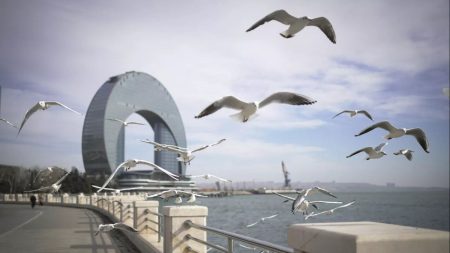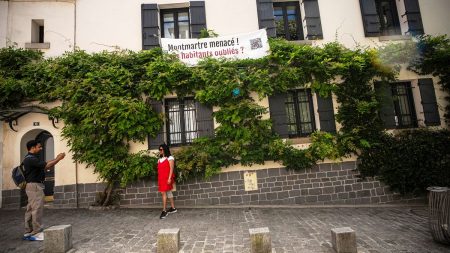Authorities in a town in Japan had erected a large fence earlier this year to block the view of the famous Mount Fuji after being overwhelmed by tourists. The 20-meter long and 2.5-meter high fence covered with black mesh was put up as a precaution when a typhoon was forecast. Locals were tired of tourists blocking pavements and stopping traffic to take photos. The popular photo location outside a convenience store, dubbed “Mt. Fuji Lawson” by visitors, was causing issues such as littering, ignoring traffic lights, and trespassing into private properties. The town decided to take action to address these behavior problems.
Despite some tourists initially exploiting small holes in the fence to snap pictures of the iconic view, the screen ultimately helped ease congestion in the area. The town spent 1.3 million yen to install the black mesh net and additional fences along the sidewalk. However, officials noticed more respect for the measure as the screen remained in place. The town was receptive to tourism but faced challenges in managing visitor manners and ensuring the safety of both tourists and locals. The decision to erect the screen was part of an effort to address these issues and promote responsible tourism practices in the area.
Mount Fuji also faced challenges with overtourism, prompting the Yamanashi prefecture to introduce a booking system for climbers. Only up to 4,000 climbers are allowed to enter the trail per day for a hiking fee, with an additional option of donating for conservation during the climbing season. The booking system aimed to address overcrowding, littering, and safety risks on the mountain. As a UNESCO World Cultural Heritage site, Mount Fuji is a popular destination for hikers seeking to climb the summit to watch the sunrise. However, concerns about the amount of trash left behind by visitors have become a major issue that needs to be addressed.
Kawaguchiko is not the only location facing challenges with overtourism. Other destinations around the world have also grappled with managing visitor numbers and behavior. In Japan, the Geisha district of Kyoto has closed off some streets to tourists due to misbehavior. Menorca’s most popular tourist attraction has introduced visiting hours to limit visitor numbers. Venice, one of Italy’s most popular destinations, has implemented measures such as a daytripper fee and banning loudspeakers to manage the influx of tourists, who often outnumber residents. These efforts reflect a broader trend of destinations trying to strike a balance between welcoming tourists and preserving their cultural and environmental heritage.
The town of Fujikawaguchiko decided to take down the fence blocking the view of Mount Fuji as an initial precaution when a typhoon was forecast. Despite initially facing challenges with tourists exploiting small holes in the screen to take pictures, officials found that the screen helped reduce congestion in the area. However, the authorities warn that the screen could be reinstalled if tourists return in large numbers. The decision to erect the screen was a response to issues of littering, traffic congestion, and other behavior problems caused by tourists visiting the area. The town is working to promote responsible tourism practices and ensure the safety and well-being of both visitors and locals.
In response to challenges with overtourism, the Yamanashi prefecture introduced a booking system for climbers on Mount Fuji to address issues of overcrowding, littering, and safety risks. Only a limited number of climbers are allowed to enter the trail per day, with a fee for hiking and an option to donate for conservation. Mount Fuji, a UNESCO World Cultural Heritage site, attracts hikers seeking to climb the summit to watch the sunrise. Concerns about the amount of trash left behind by visitors have prompted measures to ensure the preservation of the mountain’s natural beauty. These efforts reflect a broader trend of destinations around the world seeking to manage overtourism and maintain a balance between tourism and environmental conservation.









